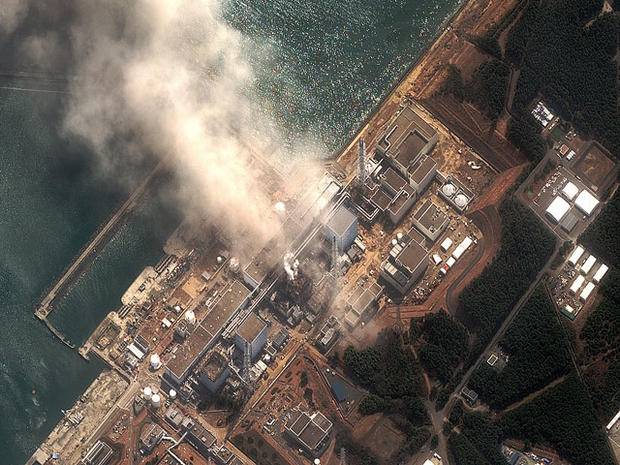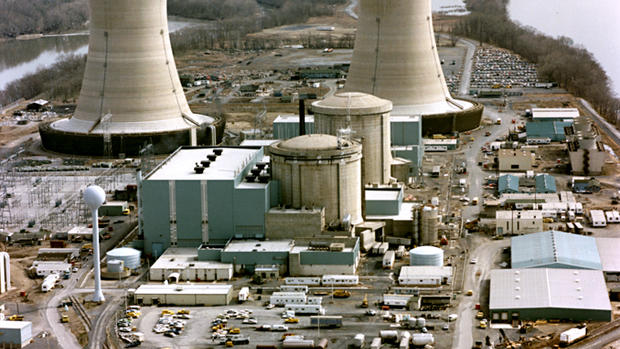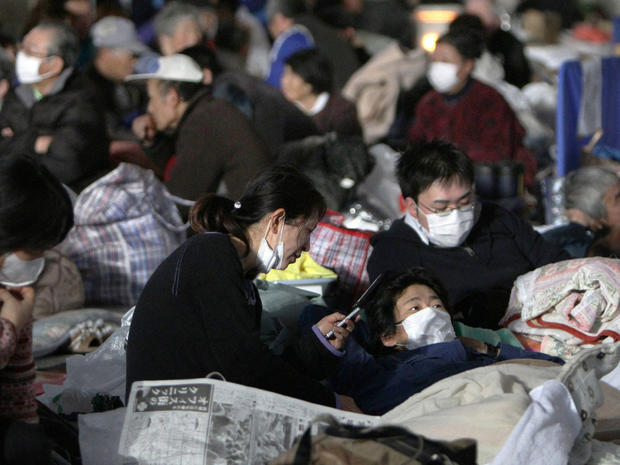Japan nuke plant spewed radiation after blast, fire
Updated 3:21 a.m. ET
(CBS/AP) A fire at a fourth reactor in a quake-damaged nuclear plant sent radiation spewing into the atmosphere Tuesday. Earlier, a third explosion at the plant in four days damaged a critical steel containment structure around another reactor, as Japan's nuclear radiation crisis escalated dramatically.
The radiation level was elevated to a point that may damage health, a government spokesman acknowledged, though the exact amount of radiation leaked was still unclear.
Prime Minister Naoto Kan and other officials warned there was danger of more leaks and told people living within 19 miles of the Fukushima Dai-ichi complex to stay indoors to avoid exposure that could make people sick.
"Please do not go outside. Please stay indoors. Please close windows and make your homes airtight," Chief Cabinet Secretary Yukio Edano told residents in the danger zone."These are figures that potentially affect health. There is no mistake about that," he said.
The International Atomic Energy Agency, the United Nations' nuclear watchdog organization, confirmed that radioactive material was released into the atmosphere as a fire burned in a storage pond for spent nuclear fuel at the stricken plant.
The IAEA said Japanese officials told it that the fire was in a pool where used nuclear fuel is kept cool and that "radioactivity is being released directly into the atmosphere.''
Japanese officials later said the fire, in Unit 4 of the Fukushima Dai-ichi plant, had been extinguished.
After a third explosion in four days rocked the earthquake-damaged Fukushima Dai-ichi nuclear plant in northeast Japan early Tuesday, the country's nuclear safety agency said the explosion may have damaged a reactor's containment vessel.
Following the fire, explosion and public warning, only 50 of the plant's 800 or so workers will remain at the site to pump seawater into three stricken reactors at the plant, in order to minimize exposure to unhealthy levels of radiation, reports the New York Times.
Earlier fears that the prevailing winds could blow a cloud of radioactive particles deeper into the country were tempered later Tuesday by the World Meteorological Organization's forecast of a change in wind direction, reported Reuters news agency.
"At this point, all the meteorological conditions are offshore so there are no implications, for Japan or other countries near Japan," Maryam Golnaraghi, chief of WMO's disaster risk reduction division, said in Geneva.
At a shelter in Sendai, workers told CBS News that everyone must avoid Tuesday's rain, as it carries nuclear radiation. Officials in far-off Tokyo have already detected slightly higher-than-normal radiation levels there, but insist there are no health dangers.
After Tuesday's fire and separate explosion at two reactors in the Fukushima Dai-ichi nuclear plant, officials just south of the area reported up to 100 times the normal levels of radiation, Kyodo News agency reported. While those figures are worrying if there is prolonged exposure, they are far from fatal.
Tokyo reported slightly elevated radiation levels, but officials said the increase was too small to threaten the 39 million people in and around the capital, about 170 miles away. Closer to the stricken nuclear complex, the streets in the coastal city of Soma were empty as the few residents who remained there heeded the government's warning to stay indoors.
The concern of radiation spreading on the wind prompted some foreign news organizations on Tuesday to pull their staff further out of areas immediately surrounding the damaged reactors.
CBS News correspondent Celia Hatton reported Monday from the seaside resort town of Koriyama, in Fukushima prefecture, but on Tuesday, she was headed south for Tokyo -- a 10 to 12 hour taxi cab journey, as there were no flights available.
Special report: Disaster in Japan
Nuclear meltdowns explained
How Fukushima explosions differ from Chernobyl
The cascading troubles in the Fukushima Dai-ichi plant compounded the immense challenges faced by the Tokyo government, already struggling to send relief to hundreds of thousands of people along the country's quake- and tsunami-ravaged coast where at least 10,000 people are believed to have died.
Japanese nuclear authorities insist they are in control, reports Hatton. Chief Cabinet Secretary Yukio Edano said the situation will not turn in to another Chernobyl.
Prime Minister Kan said the government was setting up a joint response headquarters at Tokyo Electric Power Co.'s main office to better manage the crisis.
Later, a top Japanese official said the fuel rods in all three of the most troubled nuclear reactors appeared to be melting.
Nuclear energy experts disagree on the severity of the current situation.
"There was and will not be any significant release of radioactivity" at the damaged plant, said Josef Oehmen, a research scientist at MIT. "By 'significant,' I mean a level of radiation of more than what you would receive on, say, a long distance flight, or drinking a glass of beer that comes from certain areas with high levels of natural background radiation."
In fact, the biggest concern the Japanese people should be having right now is about their electricity supply, Oehmen said, adding that they could expect periodic shortages and higher prices in the near future.
Others disagree with Oehmen's calm assessment.
"It's way past Three Mile Island already," Frank von Hippel, a physicist and professor at Princeton, told the New York Times. "The biggest risk now is that the core really melts down and you have a steam explosion."
The troubles at the Dai-ichi complex began when Friday's massive quake and tsunami in Japan's northeast knocked out power, crippling cooling systems needed to keep nuclear fuel from melting down.
The latest explosion was heard at 6:10 a.m. local time on Tuesday, a spokesman for the Nuclear Safety Agency said at a news conference. The plant's owner, Tokyo Electric Power Co., said the explosion occurred near the suppression pool in the reactor's containment vessel. The pool was later found to have a defect.
International scientists have said there are serious dangers but not at the level of the 1986 blast in Chernobyl. Japanese authorities were injecting seawater as a coolant of last resort, and advising nearby residents to stay inside to avoid contamination.
Tokyo Electric Power said some employees of the power plant were temporarily evacuated following Tuesday morning's blast.
The accidents - injuring 15 workers and military personnel and exposing up to 190 people to elevated radiation - have compounded the immense challenges faced by the Tokyo government.
The crisis also has raised global concerns about the safety of such reactors at a time when they have enjoyed a resurgence as an alternative to fossil fuels.
How you can help
Submit your photos and video to CBSNews.com
Japan disasters' economic impact
Japanese authorities said there have been no large-scale radiation releases, but have detected temporary elevations in levels, and have evacuated tens of thousands of people from around affected reactors. Prevailing winds were pointing out to sea, and U.S. ships assisting tsunami recovery moved further way to avoid potential danger.




